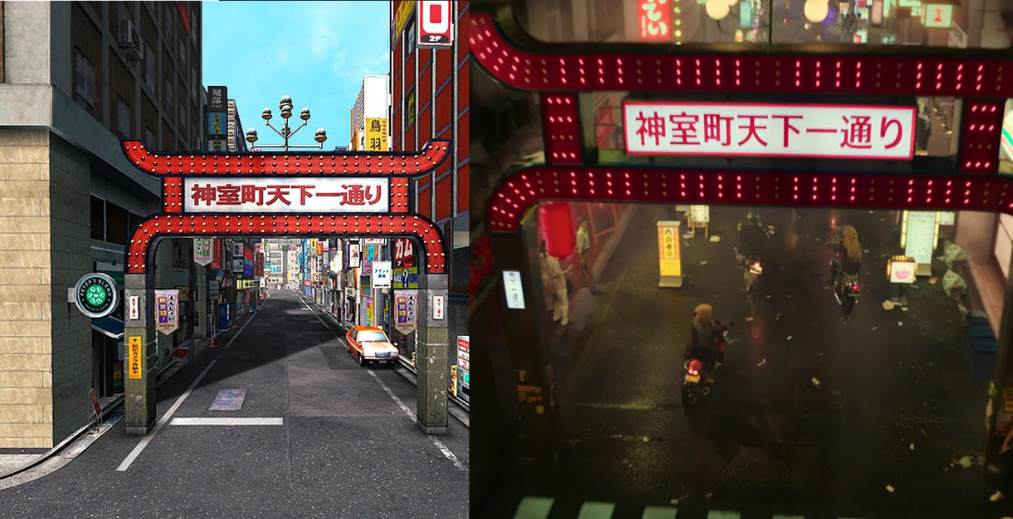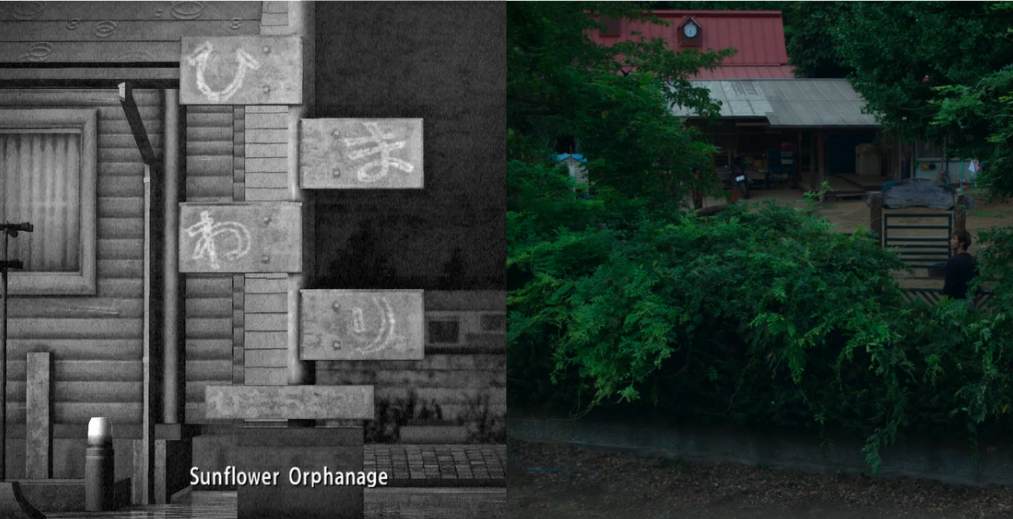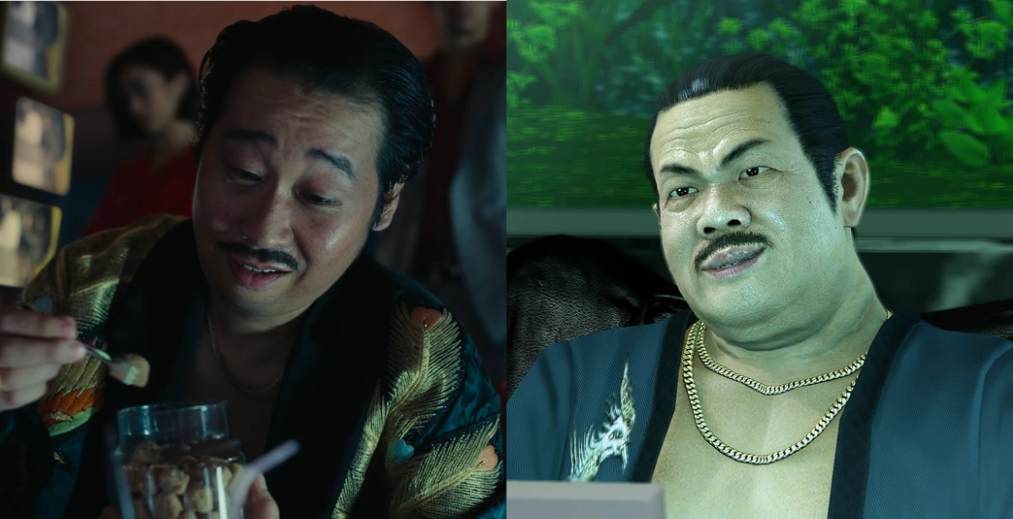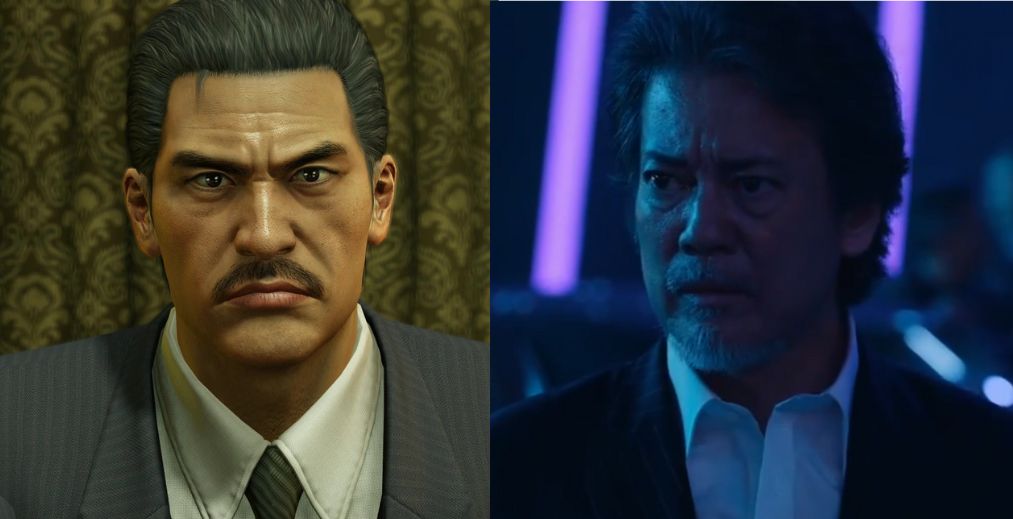Like a Dragon: Yakuza is finally out on Prime Video. Following the struggle between longtime friends Kazuma Kiryu and Akira Nishikiyama, the series also has plenty of callbacks and easter eggs to the long-running game series.
KICKING OFF IN KAMUROCHO

The series’ first major set piece has to start in Kamurocho, one of the games’ most storied and important locations. It’s based on the real-world location of Kabukicho, and it draws plenty of visual inspiration from it. Kamurocho is the seedy home of Kiryu and many other Yakuza, filled with activities and wild characters. The opening sets the tone perfectly, taking us through the iconic red Tori gate, showing off bombastic yakuza on motorbikes and crowded streets.
As the opening heist kicks off, Kiryu, Nishikiyama, Yumi, and Miho are in the midst of robbing an arcade. There are plenty of arcades across the Yakuza series, and there is a regular stop for side activities and games. We can also see glimpses of Theater Square, packed to the brim with people. It’s called Fountain Square in the series, a change-up from the games, but visually looks almost identical.
SUNFLOWER ORPHANAGE

The Sunflower Orphanage is one of the most important locations in the series. The place that Kiryu, Nishikiyama, Miho, and Yumi grew up in is more realized here, as they spend much more time in the company’s home than in the first game. It shares a visual identity with the Morning Glory Orphanage, one that Kiryu opens and runs later in Yakuza 3.
SERENA

The iconic bar appears in the series, though transformed into a hostess bar. In the games, it’s run by Reina, a close friend and ally to Kiryu. It’s a safe haven for them, one that’s regularly used as a place of respite between battles and plot twists. In the series, while it’s still run by Reina in 1995, it’s a much bigger and fancier affair. Full of yakuza, hostesses, and alcohol, it’s a far cry away from the quiet bar Kiryu calls home.
HEAT ACTIONS

One of the coolest parts of any Yakuza fight are the heat actions, brutal assaults that seriously mess up Kiryu’s enemies. We see a few of them referenced here, from smacking two assailants heads together, tossing enemies at walls, making enemies stab themselves with their own knives, smashing and dragging their faces across walls, and Kiryu’s iconic head to head smash. The show captures Kiryu’s brawler attacks and finishing moves well, even slowing down time for impact, just like the games.
KAMUROCHO UNDERGROUND FIGHT CLUB

Kiryu starts throwing down in Kamurocho’s Underground Fight Club, intent on making a name for himself and becoming the Dragon of Dojima. Fight clubs have appeared multiple times throughout the Yakuza franchise, from the Cat Fights in Yakuza 0, to the underground Coliseum in Purgatory across the series. Known for huge fights and plenty of cash, the fight club in the series is much grittier and darker. It’s a more personal location for Kiryu with high stakes, while the games’ clubs were usually grand and flashy.
MILLENIUM TOWER

A mainstay from the series, planted in the heart of Kamurocho, is Millenium Tower. A massive center and usually home to many closing fights in the games, it remains an important location in the series. The show even recreates a visual we’ve seen many times across the games, with Kiryu looking up at it after being released from prison, a towering behemoth of how things have changed since he got locked up.
CABARET CLUB DRESS UP

As Yumi and Miho join Serena, we get a scene with Reina that looks a lot like the cabaret club dress-up mini-game from Yakuza 0. As Reina helps them find their style, with a dress for their new jobs, the shot changes quickly across different dresses and styles. Yakuza 0 has a mini-game where you do just that, as Majima Goro runs a cabaret club in Sotenbori. It’s also a mini-game in Yakuza Kiwami 2, this time centered on Kiryu helping a failing club. It’s a fun reference to one of the most beloved mini-games from the games.
TAIGA SAEJIMA

Goro Majima makes his debut in episode two, with none other than his long time friend and comrade, Taiga Saejima. Another beloved character from the Yakuza series, Taiga, is a monster in combat while simultaneously having one of the biggest hearts and caring deeply about his friends. While he hasn’t appeared in the series for long, having actually joined the games in Yakuza 4, it was awesome to see him. Hopefully, we get more of him later on.
KEIJI SHIBUSAWA

When Kiryu and company arrive in Kamurocho, they’re taken to their new home by none other than Keiji Shibusawa, a major antagonist from Yakuza 0. In the games, Keiji has his own family and is a power hungry threat, constantly at odds with Kiryu. In the show, they have a much closer relationship, with Shibusawa acting in more of a mentor role.
FUTOSHI SHIMANO

Another familiar name with a much different role in the show is Futoshi Shimano. Appearing first in the scene with the Tojo Clan assembled, Shimano doesn’t do much in the show thus far. In the games, he’s a massive pain in the ass and antagonist across both Yakuza 0 and Yakuza Kiwami. He’s ruthless and conniving, always trying to get his way using whatever means possible. Time will tell if the show’s version ends up anything like the games.
HARUKA SAWAMURA

YES, Haruka IS in the series. A fun surprise that was hidden during the trailer, Haruka’s introduction is quite similar to the one in the games. In the show, she’s in a manga cafe that gets attacked by yakuza, a bloody mess as she runs and hides before she’s saved by Kiryu. In the games, Kiryu similarly finds her hiding with a gun in her hand and bodies all over the floor of a bar. It’s so exciting to see her here.
THE FLORIST OF SAI

Another major recurring character joins the fray in episode 3, with the Florist of Sai making his debut. The characters are similar in function but incredibly different in personality. Instead of operating and running Purgatory, an underworld location in Kamurocho, he’s based out of Millennium Tower. In the show, he’s a sleazy ex-cop who operates as an information broker, working with a team of people.
While he has a similar story in the games and operates functionally the same as Kamurocho’s watcher, he’s much less gross. While still a careful and conniving businessman, he’s also much more willing to help and less creepy than he is in the show. Yumi and Kiryu go to him for help, and even his offer is similar to the one in the games. To get the information they’re after, Kiryu promises to battle in the underground fight club again. In the games, Kiryu had to brawl in the Coliseum in Purgatory.
KIRYU & THE HOMELESS POPULATION

Across the entire Yakuza series, Kiryu often spends time with the large homeless population living in Kamurocho. In the games, there is an entire section of the city where they live known as West Park. The Yakuza series generally does a fantastic job humanizing these characters rather than making them the butt of a joke. The show continues this in a small way, as a homeless man helps Kiryu and Yumi in their hunt for the Yumi’s sister.
MIHO’S ILLNESS

In both the show and the games, Nishikiyama’s sister becomes ill, though in different ways. In the games, we never actually meet Yuko, her name differing from the show’s Miho. Her story plays out in a similar fashion, with a few major differences. In both, Nishikiyama makes a deal with a shady part of his Yakuza family to try and save her, getting double crossed in the show and the game. In the games, when Yumi is almost sexually assaulted by Dojima, Nishiki shoots him to save her. Kiryu takes the fall as Yuko’s surgery is around the corner, giving him more time with her. In the show, Nishiki shoots Dojima after she passes for revenge for Dojima’s lies, with Kiryu still acting as the murderer.
KIRYU’S TATTOO

Kiryu’s giant back tattoo of a dragon is one of the most iconic visual pieces in Yakuza. The tattoo is similar in both, interestingly unfinished in the show as it was in Yakuza 0. In the games, the outline is present in Yakuza 0, with it being filled in later. The eyes are missing in Like a Dragon: Yakuza, as Kiryu gets more of the tattoo done as he wins fights in the underground fight club.
IT ALL ENDS AT MILLENNIUM TOWER

As is almost tradition in the games, the show’s final confrontation takes place at Millennium Tower. Almost every Yakuza games has at least a part, if not the entirety, of the final moments of the core fight at the tower. Kiryu and Nishiki’s fight happens here across both iterations, with differences in Nishiki’s final moments. In the game, Nishiki sacrifices himself to save Kiryu, blowing up a bomb by shooting it. In the show, Nishiki stabs himself, no longer able to continue his fight against his friend.
KIRYU GOES SHIRTLESS

It wouldn’t be a Yakuza finale without Kiryu taking his shirt off. In the games, it’s an iconic move, one that Kiryu usually does as the final fight starts. In the show, while Kiryu does take off his shirt in the final fight, his reasons for doing so are much different. He frantically uses his shirt to try and stop the bleeding from Nishiki’s fatal wound. Instead of doing it to beat sense into the antagonist, he does it to try and save a friend.
KAZAMA’S SECRETS

Shintaro Kazama is one of the series most interesting characters. His presences is felt a lot across the games, with him being a massive role model for Kiryu. He’s incredibly cunning and smart, making moves and revealing secrets when he needs to. In the show, Nishiki spends his final moments letting Kiryu know that his parents’ killer was nearby. The final episode ends on a massive cliffhanger as Kiryu figures out that was Kazama. In the games, Kazama tells him himself as things unfold. His story could continue to play out in a potential Season 2, so I won’t spoil more of it here. Just know there is a lot more to this man than meets the eye.
“KIRYU-CHAAAAAN!”

Majima Goro finally reappears in the final showdown between the Ohmi and Tojo, wreaking havoc with his trusty bat. As the fight ends and Kiryu appears carrying Nishiki, we get one of, if not the most, iconic line across Yakuza. Majima gleefully yells, “KIRYU-CHAN!” as he sees him, with actor Munetaka Aoki delivering the line perfectly. Their relationship is a core part of the franchise, and I hope we get to see more of it if the show returns for a season 2.
So many of the games have been touched on in some way, shape, or form, making it a fun watch for long-time series fans. With Season 2 currently unconfirmed, fans will have to wait to see if we’ll get more of the series. If you’re looking for more in the meantime, Yakuza Kiwami just launched on Switch, with the rest of the series readily available on almost every major place you play games. It’s well worth your time.
Like a Dragon: Yakuza is available in full now on Prime Video.







